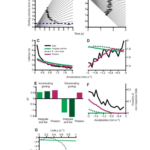Paper, Whole-field visual motion drives swimming in larval zebrafish via a stochastic process
Caudo-rostral whole-field visual motion elicits forward locomotion in many organisms, including larval zebrafish. Here, we investigate the dependence on the latency to initiate this forward swimming as a function of the speed of the visual motion. We show that latency is highly dependent on speed for slow speeds (1.5 s, which is much longer than neuronal transduction processes. What mechanisms underlie these long latencies? We propose two alternative, biologically inspired models that could account for this latency to initiate swimming: an integrate and fire model, which is history dependent, and a stochastic Poisson model, which has no history dependence. We use these models to predict the behavior of larvae when presented with whole-field motion of varying speed and find that the stochastic process shows better agreement with the experimental data. Finally, we discuss possible neuronal implementations of these models.
Learn about our two Decals!
 Click here to find out more about our Fall Bioinspired Design Decal and our Spring Bioinspired Design in Action Decal – ALL MAJORS are welcome.
Click here to find out more about our Fall Bioinspired Design Decal and our Spring Bioinspired Design in Action Decal – ALL MAJORS are welcome.Berkeley BioDesign Community
 Click here to learn about the BioD: Bio-Inspired Design @ Berkeley student organization or here to signup for more info.
Click here to learn about the BioD: Bio-Inspired Design @ Berkeley student organization or here to signup for more info.Search
Student Login





I imagine that the neurological circuits underlying these processes are governed by both 2d spacing maps with their brains as…
to reduce the impact of car accidents, it may be possible to study the force diverting physics of cockroaches to…
you see this type of head-bobbing stability in many avian creatures related to pigeons like chickens. the head ability to…
not like they taught horses how to run! this is an example of convergent evolution where both sea creatures and…
The brain functions in a similar way with neuronal connections. our brains are able to utilize the multiplicity of connections…